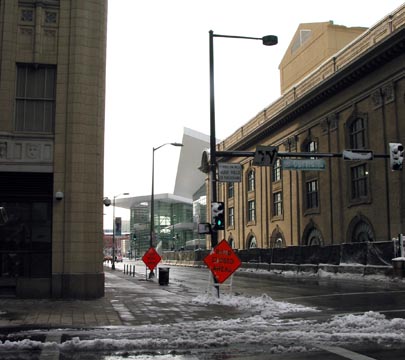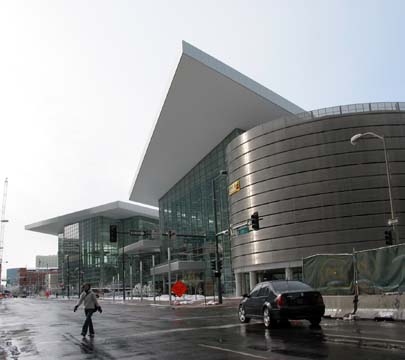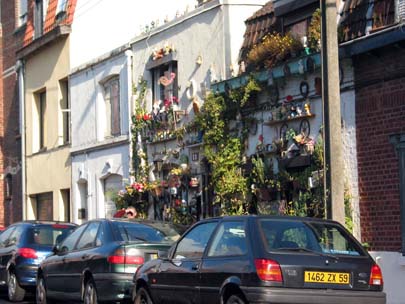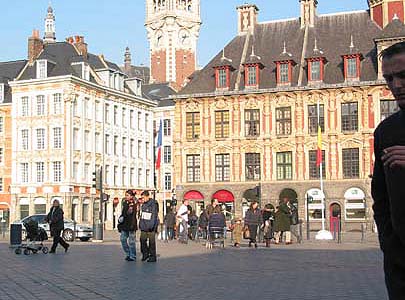While it varies both in how it is defined and how it is put into practice, Urban Design has gained prominence across the Anglo-American world in recent years. It combines key aspects of Architecture, Landscape Architecture, Urban Planning, and Civil Engineering, reaching in important ways beyond each of those disciplines. Urban Design practitioners give shape and form to city blocks, districts, and metropolitan areas, articulating urban plans in four dimensions, including space and time (how we experience an urban place as we move through it).

Combining 'old' and 'new' architectural idioms, this Denver example shows how urban design can make the most of the way we experience urban space as we move through it.


Urban Designers increasingly occupy a central role in the development and redevelopment of cities. They must draw simultaneously on the analysis and policy roles of Urban Planners as well as the form-giving and aesthetic-quality responsibilities of Architects. Through collaborative discussion and debate with communities and key stakeholders, Urban Designers derive the rules, guidelines, and frameworks that developers, Architects, and builders must follow for creating and manipulating the built environment.
In practical terms, Urban Design provides a set of descriptive and analytical tools for working with the tangibles of landscape, built form, land use, and hard infrastructure. Its concepts and methods also enable us to examine and make sense of how people use space. Critical, then, is ‘life between buildings’ (as Danish Architect Jan Gehl described it in the English title of his 1996 book). Urban Design often also encompasses economic projections, creating and ‘marketing’ a distinctive look for new developments, negotiating public/private financial partnerships, setting up guidelines and standards for historic revitalisation, as well as forming non-profit corporations that link citizens with public- and private-sector financing (Batchelor & Lewis, 1986).
Unlike what was done in the past under the auspices of grandiose civic Architecture (the Boulevards of Paris, for instance) or modernist Urban Planning (the massive rebuilding of North American city centres in the 50s and 60s, for instance), contemporary Urban Design is not simply the act of manipulating the built environment, nor is it even limited to the creative alignment of strategic interests that effect change in urban form. It is about making places that are well-liked and well-used by people. In the words of the Urban Design Group (2003), an interdisciplinary British professional forum for scholars and practitioners alike:
Good Urban Design helps to create successful places where people want to live, work, and play... What gets Urban Designers out of bed in the morning is the challenge of creating a place that will be used and enjoyed by a wide range of different people for different purposes, not only now but in years to come.
In brief, the contemporary practice of Urban Design focuses on making the most of urban areas to create pleasant places in which to linger, to partake of public life, and to help build strong, tolerant, progressive civil society.

Places for gathering in cities: a major preoccupation of urban design (Calgary).
Pedestrian-scaled, visually appealing places such as the main squares of pre-industrail European cities offer many important lessons for good urban design (Lille, France).
Why does Urban Design matter?
Significant changes have been seen in how urban growth and development are managed over the past 30 years. In Europe and North America, the advent of a post-industrial economy, the rise of the environmental movement, and the critique of top-down government decision-making have called for new approaches, both conceptually and methodologically, to the design and construction of urban environments. Traditional master plans are making way for more strategic plans and for ‘urban projects’ that improve key sites in metropolitan areas. As cities must deal with the obsolescence of old industrial areas and face growing competition for knowledge workers, their officials and civic leaders recognize the need for high-quality urban and natural environments. They are doing so increasingly in partnerships linking the public and private sectors and with significant public input.

Urban design strategies were used in this Amsterdam suburb to allow multiple modes of transportation (automobile, tramway, bicycle, and pedestrian) to coexist without having to jockey for road space.
These economic and political transformations accelerated the rise of Urban Design in the fields of Architecture, Planning, and Landscape Architecture. Its growing prominence reflects a general recognition that human environments are inherently complex and diverse and the consequent need for design interventions to acknowledge local social, historical, and environmental contexts.
Britain’s trailblazing Urban Design Group offers the following justifying statement for why Urban Design is important and useful in the contemporary world of professional practice:
Urban design is a key to making places that are successful both socially and economically, good to live in, and attractive to visit. Urban design is essential in creating community identity. It is effective planning in the widest sense, and it can help to deliver better public services. It also helps to achieve value for money in new developments, and to make good use of scarce resources. (UDG, 2003)

Urban Design is ultimately a strategic way of meeting the challenges of ‘sustainable development’. In its emphasis on rebuilding settlements to make them better, it aims to operationalise strategies for balancing ecology, economy, and the social realm. A recent European Union study (WGUDS, 2004) commissioned to deliver a set of recommendations to inform the EU’s Thematic Strategy on the Urban Environment focused on the importance of redesigning and retrofitting existing urban areas to support sustainability goals, and ultimately ‘knitting the urban fabric together’ to achieve a more fully-integrated whole across metropolitan regions.

Waterfront complexes combing public and private uses, such as Lonsdale Quay complex in North Vancouver, are good examples of urban design in practice.
Urban Design is vital in the 21st century because it engages the totality of design, including Architecture, Landscape Architecture, and Urban Planning. It is comparable to (and to some degree interchangeable with) other evolving, critical interdisciplinary paradigms for dealing with growth and change in settlements of all sizes, such as landscape research and environment-behaviour studies. Setting Urban Design apart is how it serves as the critical, catalytic link across disciplines and professions - hence the following definition provided by the Dictionary of Urbanism (2005):
… the collaborative and multi-disciplinary process of shaping the physical setting for life in cities, towns, and villages; the art of making places; … [which] involves the design of buildings, groups of buildings, spaces, and landscapes, and the establishment of frameworks and processes that facilitate successful development.
Degree programs in the design and planning fields have begun reflecting these social and intellectual changes, with new courses on Urban Design, environmental planning, and citizen participation. Increasingly, an emphasis is placed on the need to strategically implement physical changes in the city, modelling and shaping environments by understanding the relationships between places and institutions. Contemporary Urban Design is a reflection of these transformations, and a vital agent of positive change.
Intellectual and professional foundations
Historically, Urban Design has drawn on the professional disciplines of Architecture, Landscape Architecture, and Urban Planning. It has also increasingly borrowed through the 20th century from other intellectual fields to create a sophisticated interdisciplinary field. In addition to disciplines such as civil engineering and art history, it is now informed by concepts, methods, and lessons from sociology, anthropology, cultural landscape studies, environmental psychology, human geography, and health studies.
Congruent with emerging and closely-related approaches such as ecological design and industrial ecology, contemporary Urban Design is based on two vital imperatives:
- Assessing the quality of urban form and structure according to various performance criteria, including the identification of particular problems and opportunities;
- Developing strategies for improving the situation.
In combining detailed assessments of ‘what is’ (and ‘why it is so’) with the purposive task of making things better, Urban Design is thus a normative endeavour; as such, it must be based in rigorous problem-identification, analysis, and a clear statement of shared values and priorities.
What sort of work does an Urban Designer do?
There really is no ‘typical’ Urban Design practitioner, nor is there a ‘standard’ set of skills that, once learned, can be mechanically applied for the rest of one’s career. There are, however, several tasks that are central to Urban Design in practice:
- Describing characteristics of and transformations in particular settlement patterns, including morphological and typological studies;
- Examining the operative relationships linking power, politics, and the form of cities and urban areas;
- Exploring, analysing, and drawing conclusions related to the images and meanings people have of different urban environments; and
- Describing, interpreting, and shaping the built and natural environment of cities and metropolitan regions, for other professionals, decision-makers, and ‘lay’ populations.


Good urban design enfolds ecologically smart building practices, such as the carport's living roof and porous pavers (yes, that is grass) in this Swiss example (St-Gallen).
As an Urban Design practitioner, one typically works in teams with many professionals furnishing a broad range of complementary abilities. Vital insight also comes from ‘popular’ knowledge, often derived through extensive consultation with user groups through interactive workshops, meetings, and design charrettes. In consequence, emergence is a big part of reflexive practice--that is, Urban Designers learn new skills and aptitudes with each project. In large part this is because Urban Design recognises the invaluable knowledge and expertise that non-professionals bring to bear on the complex problem-solving situations.

Recognising and embracing the eclectic ways in which users personalise urban space is eminently important in responsive urban design.
How Urban Design best fits into the professional world is an area of continuing debate. There are (as yet) no professional bodies in the Anglo-American world to dictate what should be on the curriculum of an Urban Design degree program, nor what sorts of specific expertise and knowledge are needed to practise as an Urban Designer. This is not a coincidence; it is generally agreed that Urban Design is not a distinct profession in itself so much as a way of thinking, or, to paraphrase Britain’s Urban Design group, as common ground among a number of professions and/or the wide range of people involved in urban change. To practice Urban Design, however, an individual should be a registered member of professional regulating bodies in Architecture, Landscape Architecture, and/or Urban Planning.
Works cited
Batchelor, P., & Lewis, D. (Eds.). (1986). Urban Design in Action. Raleigh NC: School of Design, North Carolina State University.
Cowan, R. (Ed.). (2005). The Dictionary of Urbanism. Tisbury (England): Streetwise Press. Available online: http://www.urbanwords.info
Gehl, J. (1996). Life between buildings: using public space. Copenhagen: Arkitektens Forlag.
UDG - Urban Design Group (2003). The Urban Design Group. Available online: http://www.udg.org.uk/
WGUDS - Working Group on Urban Design for Sustainability. (2004). Urban design for sustainability: Final Report of the Working Group on Urban Design for Sustainability to the European Union Expert Group on the Urban Environment. Wien: Bundesministerium für Land- und Forstwirtschaft, Umwelt und Wasserwirtschaft.
